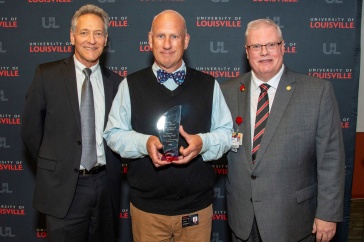
The Boy Who Loved Too Much
Jennifer Latson ’13G, Simon and Schuster, June 2017
Eli D’Angelo thinks everyone he meets is his friend. Ginny Moon struggles to connect with anyone and worries obsessively about her baby doll. In a pair of remarkable new books, recent UNH MFA graduates Jennifer Latson and Benjamin Ludwig effectively tackle the opposite sides of a single coin as they examine two very different adolescents whose towering interpersonal challenges arise from neurological dysfunction.
Latson’s “The Boy Who Loved Too Much” is a nonfiction account of 12-year-old Eli D’Angelo, who suffers from Williams Syndrome: a genetic disorder that obliterates social inhibitions, leaving him unconditionally loving and trusting — and tremendously vulnerable. Latson follows Eli and his mother, Gayle, from his ebullient preteen days into puberty, where the divide between Eli’s driving need to connect and his emotional underdevelopment becomes a vast liability. Based on three years of immersive reporting, Latson serves up Eli’s gifts and struggles (and those of Gayle, who wrestles with how much to shield her son from the world) with immense compassion, coupling his personal story with an examination of the genetic basis of behavior that adds new depth to our understanding not only of this rare syndrome but also of what it means to be human.
The Original Ginny Moon

Benjamin Ludwig ’97, ’16G, Park Row Books, May 2017
The title character of Ludwig’s “The Original Ginny Moon” might be fictional, but her first-person account of struggling as a teenager with autism to comprehend love, loss and the idea of a “forever home” with adoptive parents is strikingly authentic. Inspired in part by his own experience of adopting a teenager with autism, Ludwig creates a vivid portrait of Ginny’s obsessive anxiety and her singlemindedness and confusion as she attempts to reunite with the birth mother from whose unsafe house she was removed, and the “baby doll” she was forced to leave behind. By turns funny and frustrating, harrowing and triumphant, Ludwig’s story taps into a human truth similar to Latson’s: regardless of where you stand on the developmental spectrum, it is a fundamental need to connect and to belong.

Fish Can’t Climb Trees
Helyn Connerr ’66, ’69G, Watkins Publishing, July 2016

With the classic Albert Einstein quote, “Everybody is a genius, but if you judge a fish by its ability to climb a tree it will live its whole life believing that it is stupid,” as her launching point, scientist Connerr proposes that there are as many mental styles as there are individuals, and illustrates how each of us thinks, learns and communicates in our own unique way.

Granite, Fire and Fog: The Natural and Cultural History of Acadia
Tom Wessels ’73, UPNE, May 2017
A professor of ecology and the founding director of the master’s-level conservation biology program at Antioch University of New England, Wessels invites readers to investigate the remarkable natural history and unique cultural story of Maine’s Mount Desert Island. His sixth book focused on U.S. landscapes, Wessel’s ode to Acadia includes accounts of the nature, terrain and human interactions and offers a guided tour of one of his favorite hikes.

Geology is a Piece of Cake
Katie Coppens ’01, Tumblehome Press, May 2017
Coppens serves up a tasty introduction to rocks, minerals, fossils, geological processes, plate tectonics and more to elementary school-aged readers with an engaging question-and-answer format and recipes that illustrate science concepts — think angel cake versus fruitcake to understand the Mohs hardness scale, or the gooey center of a molten chocolate cake to represent the flow and hardening of magma into igneous rock. The results are not only scientifically spot-on, they’re also delicious.

The Stimulati Experience
Jim Curtis ’99, Rodale Books, Aug. 2017
For more than 20 years, Curtis has battled a mysterious chronic illness that defied diagnosis and traditional medical therapies. In “The Stimulati Experience,” he outlines his journey to find answers elsewhere and provides his own nine-step program to overcome pain, setback and struggle to achieve better health, freedom, joy, strength and purpose.

My Father Before Me
Chris Forhan ’87G, Scribner, May 2017

A family history, an investigation into a death and an unflinching account of growing up Irish Catholic in the 1960s and 70s. In his first memoir, award-winning poet Forham serves up a multi-generational portrait of an American family, weaving together the lives of his ancestors, his parents and his own coming of age to examine the ways in which he is and is not his father’s son, some 40 years after the elder Forhan’s suicide.

Totem Beasts
Laurette Viteritti Folk ’92, Big Table Publishing, May 2017
Part short fiction and part poetry, Folk’s second book is a meditation on femininity and femaleness, filled with intricate pieces that tackle fertility, family, death, religion and love.
Originally published in UNH Magazine Fall 2017 Issue

















































